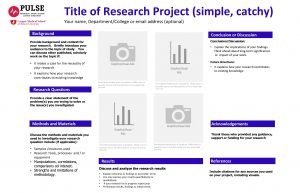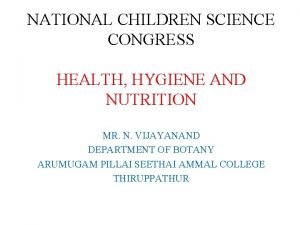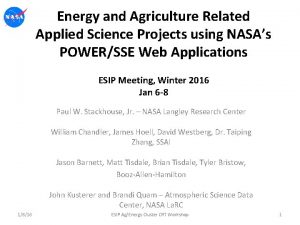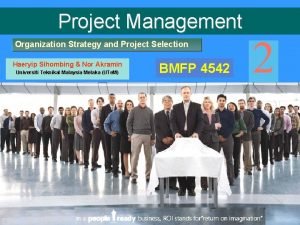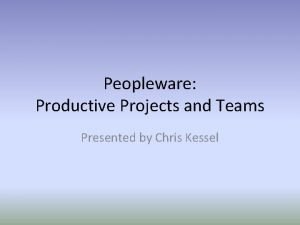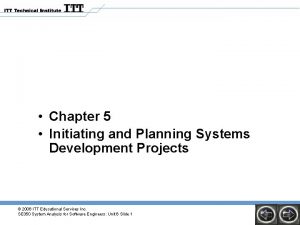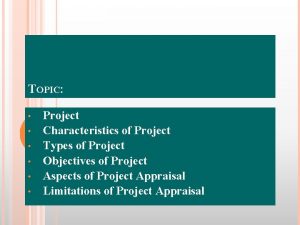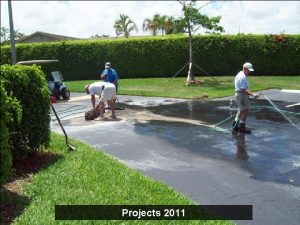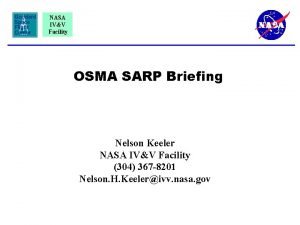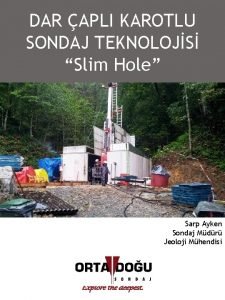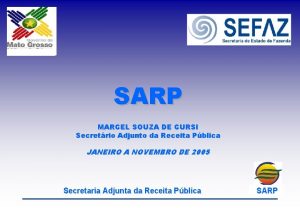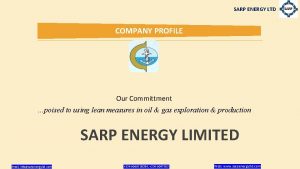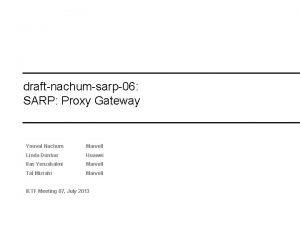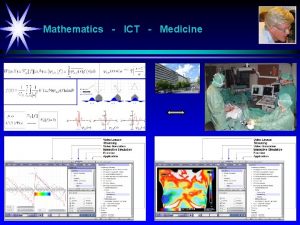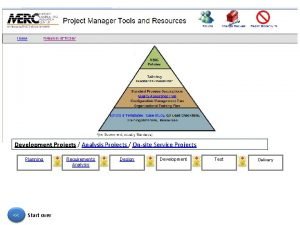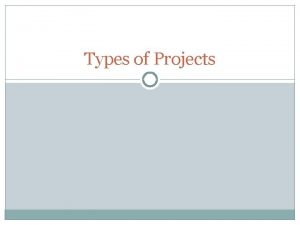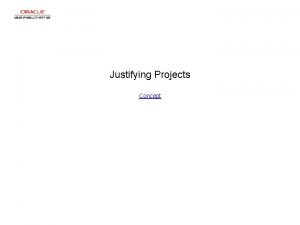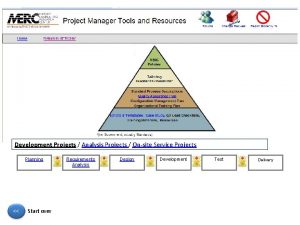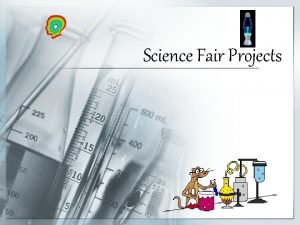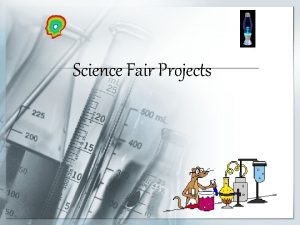SARP Science and Data Committee Science Projects Emily
























- Slides: 24

SARP Science and Data Committee Science Projects Emily Granstaff USFWS & SARP October 25, 2013 Joint SARP, EBTJV, and ACFHP Science Calls

BACKGROUND AND ORGANIZATIONAL STRUCTURE

SDC Membership • 16 State, Federal, and NGO agencies; plus 2 FHPs and reps from LCCs • Approximately 40 members – Chair: Will Duncan, USFWS-Athens, GA • Voluntary membership • Monthly conference calls and an Annual meeting

Background on the SARP Science and Data Committee • Directed by Southeast Aquatic Habitat Plan’s Integrated Conservation Strategies • Tasks for the SDC include: – Identify existing information and data gaps for aquatic – Encourage integration of relevant data from partners – Support NFHP Science and Data Committee – Work towards identifying priority areas – Identify guidelines on aquatic habitat management tools and practices – Assess progress towards objective’s targets every 5 years

Organizational Structure of Science and Data Committee Charged with the responsibilities of making big decisions, developing a vision for SARP, strategizing, using information supplied by Science and Data Committee. Steering Committee Science and Data Committee Charged with the responsibility of providing scientific technical support and expertise to steering committee, conducting habitat assessments and the science behind the strategy, and routinely corresponding with NFHAP and SARP Steering Committee also includes expertise from Southeastern Fishes Council. . New and ongoing initiatives Ad Hoc Team: Application and Validation of TN/Cumberland Assessment: Who will lead? Who will participate? What is the timeline for completion? Which objectives will we target Update of SAHP Targets: Who will lead? What is the timeline for completion? Which objectives will we target Validation Subcommittee: Tripp, Mark Cantrell, Mary Davis, Will, Mark Scott, Emily Granstaff, Glen, Tom Champlau, Roger, Steve Magnelia, Cathy Phillips Prioritization Tools Committee: Staffed and partly Funded Layout completed Science Needs Document Update: Roger, Scott, Will, Cindy W, Emily Gr. A, (Google Docs) LCC-SARP collaboration Club: Who will lead? Cathy, Glenn, Peggy, etc. What is the timeline for completion? Which objectives will we target? Whitewater to Bluewater: Emily Greene, Scott, Emily Granstaff, Will Duncan Note: Sub committees are charged with the responsibility of developing good ideas and products, and routinely vetting them with the larger Science and Data Committee. New committees can be added, and old ones removed as necessary.

SARP Project Tracking Database

SARP Conservation Focus Areas

BMP Library

DATA DEVELOPMENT AND ASSESSMENTS

River Classification • • • • Size Classes, using Cumulative Drainage Area (SARP-wide) Size Classes, using Mean Annual Flow (SARPwide) Gradient Classes (SARP-wide) Konrad’s hydrologic classification Ecoregion FEOW Annual Precipitation Classes (eastern SARP) Baseflow Index (eastern SARP) Runoff Coefficients (MAF in cfs/drainage area) (eastern SARP) Predicted Hydrologic Variability Class (eastern SARP) Geologic metrics Land form metrics Land cover metrics Soil water capacity and composition metrics

Stream Temperature Logger Sites

Riparian Assessment

Risk of Flow Alteration Assessment • Risk of Flow Alteration Assessment, v 1 • Assesses risk from 3 sources of Flow Alteration: • Impervious Surface • Evapotranspiration • Water Consumption • Risk of Flow Alteration Assessment, v 2 (in the works) (TX, OK, LA) • Updates Water Consumption model

Southeast Aquatic Connectivity Assessment Project (SEACAP) • • Southeast Stream Barrier GIS, v 1 (SARP-wide) • Inventory of available GIS datasets of fish barriers Southeast Aquatic Connectivity Assessment Project and Decision Support Tool (in the works) (eastern SARP) • Using SSBGIS and other datasets to standardize and linear reference to the NHDPlus for the purposes of inventorying and prioritizing the removal of barriers. Mainly focusing of dams.

Multistate Aquatic Resources Information System

Native Black Bass Initiative

Compilation of Partner’s Data

DATA APPLICATION

Tennessee/Cumberland Habitat Assessment

Now, we add in predicted urbanization land use change at the year 2060. All of the land in this layer has an 80% chance of becoming urban by 2060. The legend will tell you which current land use type is being converted to urban.

Aquatic Data and Decision Information Compilation Tool

Custom Scenario Visualization Tool Workflow

LCC’s Conservation Planning Atlases

SARP Science Needs
 Sarp erturk
Sarp erturk Optical illusions science fair project hypothesis
Optical illusions science fair project hypothesis Project board isef
Project board isef Astronomy science fair projects
Astronomy science fair projects Catchy titles for science projects
Catchy titles for science projects Procedure for paper airplane science project
Procedure for paper airplane science project National children's science congress projects ideas
National children's science congress projects ideas Dermatology science fair projects
Dermatology science fair projects Ns grade 7 term 3 project
Ns grade 7 term 3 project Abstract in science fair
Abstract in science fair Applied science projects
Applied science projects Big data open source software
Big data open source software Big data open source projects
Big data open source projects Sddsaa
Sddsaa What big data open source software was developed
What big data open source software was developed Big data open source projects
Big data open source projects What is your favorite subject answer
What is your favorite subject answer Consultative committee for space data systems
Consultative committee for space data systems Project portfolio matrix bread and butter
Project portfolio matrix bread and butter Peopleware productive projects and teams
Peopleware productive projects and teams Managing multiple projects objectives and deadlines
Managing multiple projects objectives and deadlines Initiating and planning systems development projects
Initiating and planning systems development projects Identification of the system for development
Identification of the system for development Characteristics and types of projects
Characteristics and types of projects Crm project plan
Crm project plan




